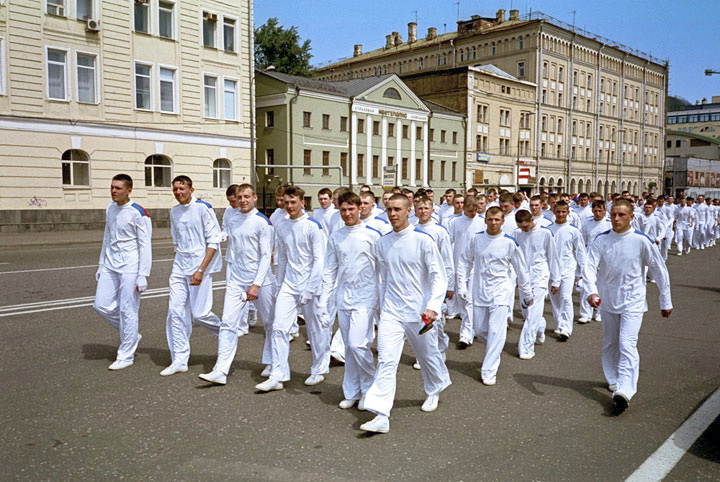Christina Erb
Lost Boys by Slava Mogutin
Book review in The Globalist, May 2007

Independence Day Parade, Moscow, 2004
Photographer Slava Mogutin’s first monograph, Lost Boys, is a compelling collection of landscape and portrait shots, comprised of a wide array of intimate and expressive images he collected over the ten years he traveled throughout Eastern Europe.
His photographic journey began after he was exiled from Russia at the age of 21 for “malicious hooliganism with exceptional cynicism and extreme insolence.” As an open homosexual, his explicitly gay words angered Soviets — and the photographs he took in the years following have caused an uproar, as well.
Like Mogutin’s words, his images are provocative and raw, revolving around the fringes of Eastern European urban culture. He shows us portraits of young, defiant men and startlingly still landscapes of snow-covered trees, an amusement park and the dilapidated city blocks of Eastern Europe.
Mogutin opens the door to a world of displaced people, underground cultures and economic instability. We see skinheads and skateboarders, punks and football players, Crimean Rasta boys and military cadets living in various states of poverty, acting out a mixture of fantasies and discovering their sexual identities.
He explains his motives and the collection’s title to independent curator and art writer Octavio Zaya in “Slava Mogutin’s Grotesque Realism,” saying, “I thought Lost Boys was a good title for this series because I was photographing all these kids around the world who were actually lost in one way or another, caught up in the world of their subcultures and fetishes.”
He offsets these kinky images with tamer, yet still poignant, portraits of young Eastern European men. He shows us a Red Cadet standing, head tilted, in front of his post, and a Russian raver all in black sitting against a wall, his forehead resting against his knees and surrounded by dozens of beer bottles.
It is a perplexing photograph. Is the boy regretting a night of partying? Is he reacting to the fall of the Soviet Union? Does he even have a home? We are forced to ask questions the photograph cannot begin to answer for us.
We see a group of boys dressed in crisp white uniforms marching in a parade and later, a young soldier named Anton smoking on top of a building, his shirt open with his helmet still securely in place.
But even these more innocent portraits are dispelled by other images. On the roof, Anton has a disheveled, hardened appearance. We see only his profile — and it is easy to wonder, in that moment, if he is caught in the middle of a war.
But the portraits that follow dispel such thoughts. They show him inside, partially dressed, acting out various fantasies. These are hard, beautiful images — and the subjects, like Mogutin, never shy away from the camera, staring straight at the lens without hesitation.
© Christina Erb